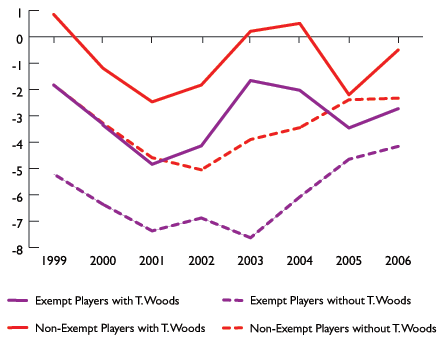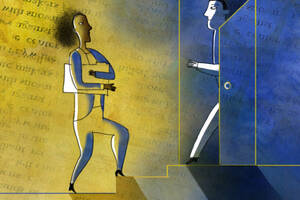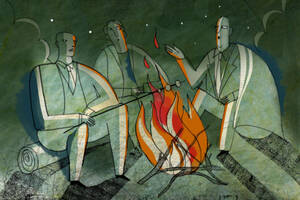Strategy Leadership Economics Jan 1, 2009
Golf Lessons
Competing with superstars adversely affects performance
When confronted by a Tiger Woods or a Michael Phelps, do challengers step up their game or throw in the towel? Managers often use internal competition to motivate employees, but new research suggests that adding a superstar to the mix might actually hurt productivity rather than help it. In a recent study, Jennifer Brown of the Kellogg School’s Department of Management and Strategy found that while competition may be beneficial among closely matched contenders, large differences in skill reduce the efforts of competitors and become counterproductive.
“Consider two sports-inspired scenarios,” Brown observes. “In the first, you face a rival of similar skill and are motivated to work harder, relative to your normal effort, in a very “winnable” race. In the second scenario, you are matched against a highly-trained athlete and your probability of winning is very low. Competing is costly and there is always the risk of pulled muscles. In this case, you may actually reduce your effort in the contest. That is, the presence of a superstar discourages you from expending your full effort in the competition.”
Differences in skill-level among workers can substantially impact both the effectiveness of tournament-style rewards programs and overall employee performance. In her working paper, Brown notes that many compensation structures revolve around tournament-style competition: firms reward the top salesperson; assistant professors compete for a limited number of tenure positions; law firm associates vie for partnerships; and professional athletes seek national titles. In these situations, rewards are based on relative performance. For example, General Electric’s former CEO Jack Welch instituted a “20-70-10” program in which the top 20 percent of employees were generously rewarded and the bottom 10 percent were “managed out.” Many other companies, like 3M, Bloomingdale’s, Procter & Gamble, IBM, Digital, Johnson & Johnson, General Motors, and Hewlett-Packard, use between-team and within-team competition to motivate employees as well.
Linking the Data
Brown explored the question of how people react when competing with a superstar by using data from all players in every Professional Golfers’ Association (PGA) tournament from 1999 to 2006. She also obtained hole-by-hole data for all tournaments from 2002 to 2006. One of the reasons Brown chose the PGA data is that golf has an undisputed superstar—during his best years Tiger Woods clearly outperformed his nearest competitors. According to Golf Digest, Tiger “finished 2007 with 19.62 points in the World Golf Ranking, more than twice as many as his closest rival. That means that he had enough points last year to be both No. 1 and No. 2. It also means that if you had divided his 2007 tournament results between two players—Tiger A and Tiger B—both would have finished ahead of Phil Mickelson.” 1
Brown considers professional golf to be “an excellent setting in which to examine tournament theory and superstars in rank-order events, since effort relates relatively directly to scores and performance measures are not confounded by team dynamics.” Examples of ways in which professional golfers may increase or decrease effort include hitting practice shots on a driving range, playing practice rounds, and studying the course before the tournament. In addition, during the tournament, a player may take extra care to consider how the ball is resting on the ground, the target, the weather conditions, and club selection. All of these are activities that require considerable effort and result in improved performance. “In fact, it is the close relationship between effort and performance that makes golf data particularly suitable for this study,” Brown explains.
In addition, golf tournaments provide a setting in which it is possible to control for many potentially confounding factors. “The nice thing about looking at golf is that I can use data about the weather, course, condition, competitiveness of the field, and so on to control for factors that affect player performance,” Brown says. “Because Woods doesn’t always play the same courses, I can look at how an individual player performs on a given course when Woods is there, compared to how that player scores when Woods is absent.”
The Superstar Effect
Brown found that golfers who compete against Woods have worse scores than they normally do. She found that the average first-round score for PGA players is approximately 0.2 strokes higher when Woods participates, relative to when Woods is absent. The overall “superstar effect” is approximately 0.8 strokes over an entire, four-round tournament. In addition, the adverse superstar effect increases when Woods is playing well and disappears during Woods’ weaker periods.
Brown examined the superstar effect on both “exempt” golfers, who automatically qualify for all PGA tournaments, and “non-exempt” golfers, who must qualify for each individual tournament. The PGA has a complicated process for determining exemptions, but generally, recent tournament winners and golfers who finished in the top 125 positions on the total earnings list in the previous season earn exempt status. Thus, exempt players are typically more highly skilled than non-exempt golfers.
Brown found that exempt players, on average, score nearly one stroke higher (worse) in tournaments in which Tiger Woods participates than they do in tournaments that Woods skips. “I find that they play worse even in that first round,” Brown reports. “The effect persists across the tournaments.” She concludes that this difference occurs because “competitors are scaling back their effort in events where they believe Woods will surely win.”
To illustrate the economic impact of the superstar effect in the PGA, Brown computed the amount by which Woods’ earnings would have been reduced if his competitors had played as well when Woods was in the competitions as they did when he was not in the field. To do this, she recalculated what the distribution of prizes would have been if all exempt players’ scores had been one stroke lower (better) when they competed against Woods. Her calculations suggest that Woods’ PGA Tour earnings “would have fallen from $48.1 million to $43.2 million between 1999 and 2006 had his competitors’ performance not suffered the superstar effect.”
Brown found no evidence that the scoring difference is due to players adopting riskier strategies, such as aggressively “going for it” when they could instead choose a more conservative approach to a shot. In addition, she says there is no statistically significant evidence that other players are intimidated by Woods. Brown concludes that other players just do not try as hard to win when Woods is playing. This is further underscored by the disappearance of the superstar effect when Woods fails to live up to expectations: “When Tiger’s in a slump or he’s having a bad day, his presence in a tournament no longer affects his competitors, whereas when he’s ‘hot’ we do consistently see this adverse effect on other players’ performance.”
She notes that when told of the results of her research, “several PGA Tour players said that they weren’t surprised by my findings, although a few of them concluded that it was more about ‘trying too hard’ versus ‘not trying hard enough.’” She adds, “This is probably less relevant in any ‘average’ business context, where managers generally care about the overall performance of the worker, not necessarily why his or her performance suffered.”
The superstar effect is not just a result of a few particularly susceptible players distorting the findings with especially horrible scores. Although some players post lower (better) scores when Woods is in the field, far more players post higher scores. But it is only Woods’ real competitors who are bothered by the superstar effect. The performance of non-exempt players, most of whom have no realistic chance of winning the tournament, remains statistically unchanged. (See Figure 1)
Figure 1: Average strokes relative to par for tournaments with and without Tiger Woods.

Note: Only scores from players who made the cut are included. Regular and major events are included; small-field and alternate events are excluded. “With T. Woods” indicates that Woods played in the tournament, while “Without T. Woods” includes only tournaments in which Woods did not participate. “Exempt” players automatically qualify for PGA Tour events. “Non-Exempt” players must qualify for individual tournaments; scores for Tiger Woods are excluded.
Brown also ruled out the possibility that golf course managers “Tiger-proof” their courses, making them more difficult when Woods is in the field. She explains, “This is where the difference between exempt and non-exempt players is key. If courses were simply harder, then we would expect both higher- and lower-skilled players to suffer the effect of Woods’ presence—lower-skilled players might even suffer more. Instead, lower-skilled players’ performance appears to be unaffected by the superstar.”
Tournament-Style Rewards Programs—Take Note
The implications of the superstar effect extend far beyond the PGA Tour, offering important insights into broader hiring, compensation, and management strategies. Brown suggests that companies that use tournament-style rewards programs need to understand that differences in skill-level among workers can substantially impact both the effectiveness of such programs and overall employee performance.
“If you have a superstar in your office and you’re going to award a big prize to the top performer, and if everyone else in the office knows from the outset who’s already clinched it, they may reduce their effort. They may think, ‘Why bother trying in this contest which I am almost surely going to lose?’”
Henry Ford once said, “Whether you think you can or whether you think you can’t—you’re right.” Brown cautions against unintentionally demoralizing workers by expecting them to compete when they believe that the deck is stacked or that they are out of their league. Instead of pitting individuals against individuals when there is a clear superstar, Brown contends that it may be more useful to devise another incentive scheme with different prizes or more evenly matched teams. In any event, she concludes, “estimating the impact of superstars is an important step toward clear answers about how to best structure competitive incentives.”
1 http://www.golfdigest.com/magazine/2008/05/owen?printable=true
Brown, Jennifer. 2011. Quitters Never Win: The (Adverse) Incentive Effects of Competing with Superstars. Journal of Political Economy, 119(5): 982-1013.


